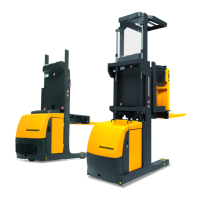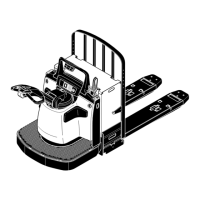03.09 EN
26
4 Charging the battery
Charging the battery
WARNING!
The gases produced during charging can cause explosions
The battery produces a mixture of nitrogen and hydrogen (electrolytic gas) during
charging. Gassing is a chemical process. This gas mixture is highly explosive and
must not be ignited.
X Switch the charging station and truck off first before connecting/disconnecting the
charging cable of the battery charging station to/from the battery connector.
X The charger must be adapted to the battery in terms of voltage and charge capac-
ity.
X Before charging, check all cables and plug connections for visible signs of damage.
X Ventilate the room in which the truck is being charged.
X The battery cover must be open and the battery cell surfaces must be exposed dur-
ing charging to ensure adequate ventilation.
X Do not smoke and avoid naked flames when handling batteries.
X Wherever a truck is parked for charging there must be no flammable material or
consumables capable of creating sparks within a 2 metre radius of the truck.
X Fire protection equipment must be provided.
X Do not lay any metallic objects on battery.
X It is essential to follow the safety regulations of the battery and charger station man-
ufacturers.
Requirements
– Battery exposed.
– Charger switched off.
Procedure
• Remove the battery connector (3).
• Remove any insulating mats from the
battery.
• Connect the charging cable (4) of the
battery charger station with the battery
connector (3).
• Switch on the charger. Charge the bat-
tery in accordance with the battery and
battery charger manufacturers’ instruc-
tions.
The battery is now charged.
3
4
03.09 EN
26
4 Charging the battery
Charging the battery
WARNING!
The gases produced during charging can cause explosions
The battery produces a mixture of nitrogen and hydrogen (electrolytic gas) during
charging. Gassing is a chemical process. This gas mixture is highly explosive and
must not be ignited.
X Switch the charging station and truck off first before connecting/disconnecting the
charging cable of the battery charging station to/from the battery connector.
X The charger must be adapted to the battery in terms of voltage and charge capac-
ity.
X Before charging, check all cables and plug connections for visible signs of damage.
X Ventilate the room in which the truck is being charged.
X The battery cover must be open and the battery cell surfaces must be exposed dur-
ing charging to ensure adequate ventilation.
X Do not smoke and avoid naked flames when handling batteries.
X Wherever a truck is parked for charging there must be no flammable material or
consumables capable of creating sparks within a 2 metre radius of the truck.
X Fire protection equipment must be provided.
X Do not lay any metallic objects on battery.
X It is essential to follow the safety regulations of the battery and charger station man-
ufacturers.
Requirements
– Battery exposed.
– Charger switched off.
Procedure
• Remove the battery connector (3).
• Remove any insulating mats from the
battery.
• Connect the charging cable (4) of the
battery charger station with the battery
connector (3).
• Switch on the charger. Charge the bat-
tery in accordance with the battery and
battery charger manufacturers’ instruc-
tions.
The battery is now charged.
3
4

